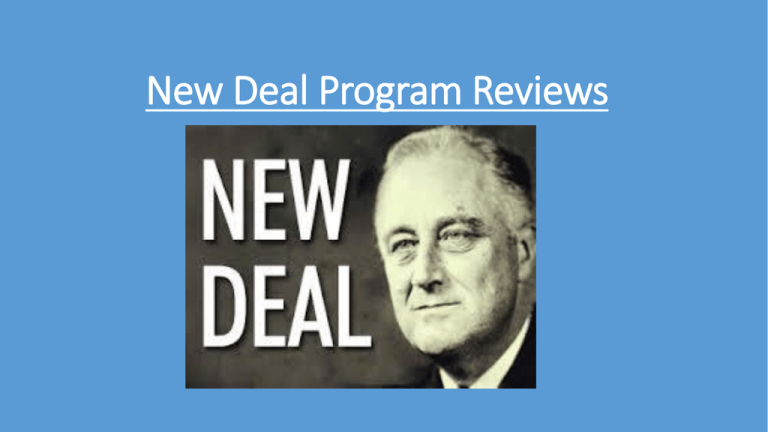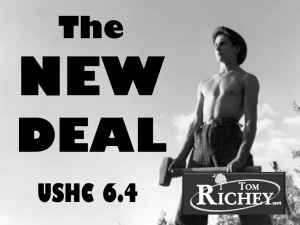16 – New Deal Program Reviews
advertisement

New Deal Program Reviews CCC: Civilian Conservation Corps CCC: Civilian Conservation Corps 1. Roosevelt hoped that the men would leave the CCC strong, rugged, and ready for reentrance into the ranks of industry equipped for the competitive fields of the industrial life of America. 2. The objective of the CCC was to recruit unemployed men for forestry, erosion control, flood prevention, and parks development. 3. The four agencies involved were: • U.S. Department of Labor- recruited men for 6 month enlistments • U.S. Department of War- provided army officers to operate 200 man camps • U.S. Departments of Interior and Agriculture- identified projects and supervised the work 4. By the presidents deadline, 274,375 men were working at 1,300 camps. 5. Robert Fechner of Georgia was put in charge of the CCC 6. Despite the CCC’s popularity in Georgia, Eugene Talmadge felt that the New Deal programs were an intrusion into state government 7. CCC camps violated laws against racial discrimination by segregating camps and discouraging or prevented African Americans from enlisting. They failed to recruit eligible blacks until the labor Department made threats. CCC: Civilian Conservation Corps 8. Projects taught lasting skills like: planting trees, constructing erosion dams, and ran telephone . 9. The CCC impacted Georgia by: • • • • • • • • • Two state parks (Indian Springs and Vogel) Built lakes and ponds Cabins and lodges Preserved historical features Constructed roads and trails Restoration of historical fortifications Chattahoochee National Forest Appalachian Trail Facilities in the Okefenokee Swamp SSA: Social Security Administration SSA: Social Security Administration 10. The SSA was signed into law by FDR on August 14, 1993 11. The SSA established multiple government programs that helped provide economic security for millions of Americans 12. Pay as you go – funded evenly by workers and employers. SSA tax is 12.4% of a worker’s earnings- half is taken from employee pay checks and half is paid by the employer. 13. Talmadge opposed the SSA because he believed in a laissezfaire attitude toward governance, and felt the SSA was another step toward destruction. 14. He blocked state legislators’ measures to establish the agency. Every US congressman and senator from Georgia voted for the SSA. 15. Overtime the SSA expanded to operate nearly a dozen social welfare programs, including Medicare, Medicaid, and Supplemental Security Income Program. REA: Rural Electrification Administration REA: Rural Electrification Administration 16. The REA is a federal loan subsidy program that assisted groups of rural farms with building and running their own electrical distribution systems 17. By 1930, 90% of urban households had electricity. 18. 10% of rural households had power. 19. Small towns remained in the dark because electric service providers found it too expensive to invest in creating an electrical infrastructure in these areas where residents were stretched too far apart. 20. FDR paid four times as much for power to his home in Georgia than he did in his Hyde Park Community in New York. 21. FDR owned a farm and was a part-time resident in Warm Springs, Georgia 22. REA established 417 cooperatives to serve 288,00 households, and raised the percentage of rural homes with electricity to 25% REA: Rural Electrification Administration 23. Five ways rural life was improved by electricity were: • • • • • • • • Lights Radio Refrigeration- including ice! Washing machine not powered by gasoline Electric pump instead of hand pump for water Iron Stoves Electric Range AAA: Agricultural Adjustment Act AAA: Agricultural Adjustment Act 24. The purpose of the AAA was to balance supply and demand for farm commodities so that prices would support a decent purchasing power for farmers. 25. The program controlled the supplies of- corn, wheat, cotton, rice, peanuts, tobacco, and milk- by offering payments to farmers to NOT plant a portion of their land. 26. Most farmers participated because they needed the money, others had the attitude that “the government can’t tell me what to do.” 27. The AAA helped revive hope in farm communities and it remained the basis for all farm programs for the next 70 years. 28. Only certain crops were eligible for the program and no livestock producers were included. AAA: Agricultural Adjustment Act 29. 40% of African Americans made their living as sharecroppers and tenant farmers. The AAA forced more than 100,000 blacks off the land in 1933 and 1934. 30. Many black leaders also criticized FDR for not supporting the anti-lynching bill and a bill to abolish poll tax. 31. FDR feared that conservative southern Democrats would block his bills if he tried to fight them on race issues. 32. TWO positives FDR’s Administration took towards Civil Rights: -FDR’s administration did make gains in civil rights by appointing Mary McLeod Bethune, a black educator, to the advisory committee of the National Youth Administration. Her leadership allowed many blacks to benefit from its work relief. -Harold Ickes, a strong supporter of civil rights had several blacks on his staff, poured federal funds into black schools and hospitals in the south.






